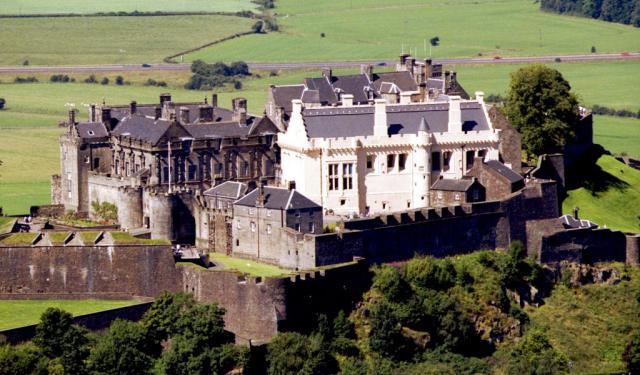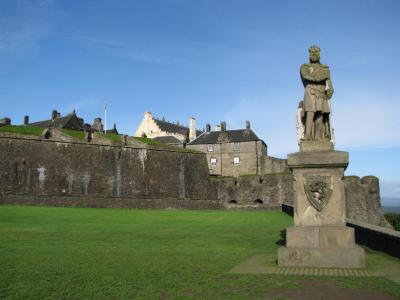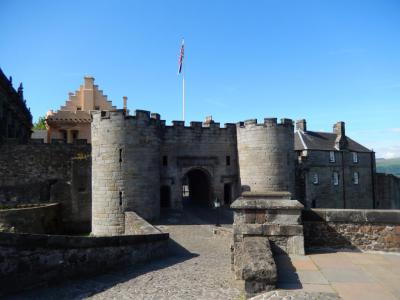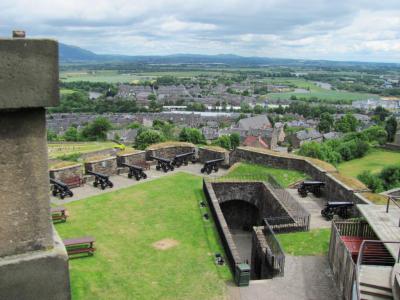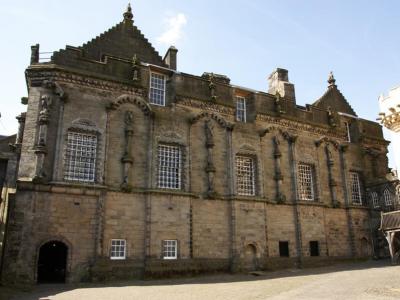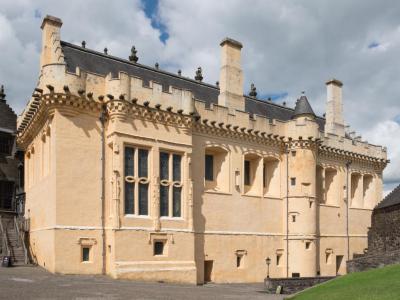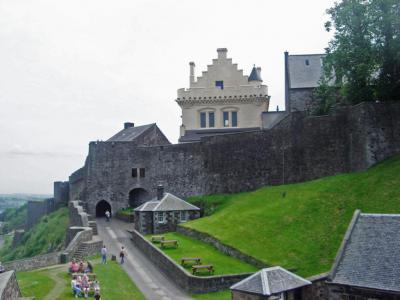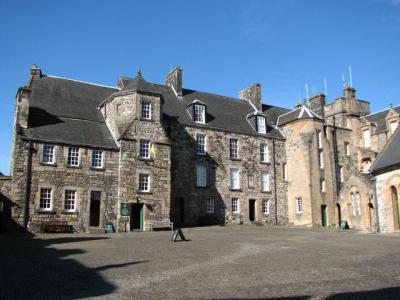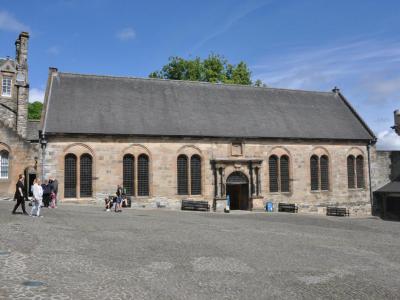Stirling Castle Walking Tour (Self Guided), Stirling
Sitting atop Castle Hill in Stirling, Stirling Castle is one of the largest and most important castles in Scotland, both historically and architecturally. Before the union with England, the Castle was also one of the most used of the numerous Scottish royal residences, acting as both a palace and a fortress. Several Scottish kings and queens have been crowned at Stirling, including Mary, Queen of Scots, in 1542, and others were born or died here.
As you approach the Castle's entrance, you can't help noticing standing guard over the esplanade, almost silhouetted against the sky, the impressive monument to one of Scotland's greatest heroes, King Robert I, popularly known as Robert the Bruce.
Most of the Castle principal buildings date from the 15th and 16th centuries. A few structures remain from the 14th century, like the North Gate, probably the oldest part of it, erected in the 1380s; while the Outer Defences, fronting the town, date from the early 18th century.
The Forework, the gatehouse providing entry from the Outer Defences into the Castle proper, contains a courtyard known as the Outer Close. From here, to the south you can reach the Royal Palace, the King's Old Building to the west, the Chapel Royal to the north, and the Great Hall to the east.
Nowadays, visitors to the Castle are often greeted with the costumed characters playing the roles of bodyguards, court officials, maids of honor and servants, thus recreating the atmosphere of a 16th-century life. To acquaint yourself more fully with the facets of Scotland's eventful past, take this self-guided walking tour back in time and enjoy yourself!
As you approach the Castle's entrance, you can't help noticing standing guard over the esplanade, almost silhouetted against the sky, the impressive monument to one of Scotland's greatest heroes, King Robert I, popularly known as Robert the Bruce.
Most of the Castle principal buildings date from the 15th and 16th centuries. A few structures remain from the 14th century, like the North Gate, probably the oldest part of it, erected in the 1380s; while the Outer Defences, fronting the town, date from the early 18th century.
The Forework, the gatehouse providing entry from the Outer Defences into the Castle proper, contains a courtyard known as the Outer Close. From here, to the south you can reach the Royal Palace, the King's Old Building to the west, the Chapel Royal to the north, and the Great Hall to the east.
Nowadays, visitors to the Castle are often greeted with the costumed characters playing the roles of bodyguards, court officials, maids of honor and servants, thus recreating the atmosphere of a 16th-century life. To acquaint yourself more fully with the facets of Scotland's eventful past, take this self-guided walking tour back in time and enjoy yourself!
How it works: Download the app "GPSmyCity: Walks in 1K+ Cities" from Apple App Store or Google Play Store to your mobile phone or tablet. The app turns your mobile device into a personal tour guide and its built-in GPS navigation functions guide you from one tour stop to next. The app works offline, so no data plan is needed when traveling abroad.
Stirling Castle Walking Tour Map
Guide Name: Stirling Castle Walking Tour
Guide Location: Scotland » Stirling (See other walking tours in Stirling)
Guide Type: Self-guided Walking Tour (Sightseeing)
# of Attractions: 8
Tour Duration: 1 Hour(s)
Travel Distance: 0.8 Km or 0.5 Miles
Author: karenv
Sight(s) Featured in This Guide:
Guide Location: Scotland » Stirling (See other walking tours in Stirling)
Guide Type: Self-guided Walking Tour (Sightseeing)
# of Attractions: 8
Tour Duration: 1 Hour(s)
Travel Distance: 0.8 Km or 0.5 Miles
Author: karenv
Sight(s) Featured in This Guide:
- Robert The Bruce Monument
- Forework of Stirling Castle
- Outer Defenses of Stirling Castle
- Stirling Castle Royal Palace
- Great Hall of Stirling Castle
- North Gate and Great Kitchen
- King's Old Building
- Stirling Castle Chapel Royal
1) Robert The Bruce Monument
The Robert the Bruce Monument at Stirling Castle is a striking tribute to one of Scotland’s most iconic kings, who ruled from 1306 to 1329. Created by Scottish sculptor Andrew Currie between 1876 and 1877, the statue reflects the growing public interest in Scottish history during the 19th century, with the project being funded by public subscription.
The stone figure of Bruce is designed as a tall, commanding presence, clad in chain-mail armor. His hand rests on the pommel of his sword, while his shield and axe lie at his feet. The pedestal features a replica of Bruce's shield, displaying the Lion Rampant, a symbol of Scottish royalty. Some metal elements, such as the axe head, sword, and parts of the shield, were incorporated into the statue, although it's uncertain whether they were part of the original design or later restorations.
Facing south, the statue looks towards Bannockburn Battlefield, where Bruce achieved a crucial victory over the English in 1314, solidifying Scottish independence for a time. The monument at Stirling Castle serves as a counterpart to another statue of Bruce, an equestrian version by Pilkington Jackson, located at the Bannockburn Visitor Centre, created in 1964.
In 2020, the Robert the Bruce monument at Stirling Castle was featured on the Clydesdale Bank's £20 note, further cementing its cultural and historical significance.
The stone figure of Bruce is designed as a tall, commanding presence, clad in chain-mail armor. His hand rests on the pommel of his sword, while his shield and axe lie at his feet. The pedestal features a replica of Bruce's shield, displaying the Lion Rampant, a symbol of Scottish royalty. Some metal elements, such as the axe head, sword, and parts of the shield, were incorporated into the statue, although it's uncertain whether they were part of the original design or later restorations.
Facing south, the statue looks towards Bannockburn Battlefield, where Bruce achieved a crucial victory over the English in 1314, solidifying Scottish independence for a time. The monument at Stirling Castle serves as a counterpart to another statue of Bruce, an equestrian version by Pilkington Jackson, located at the Bannockburn Visitor Centre, created in 1964.
In 2020, the Robert the Bruce monument at Stirling Castle was featured on the Clydesdale Bank's £20 note, further cementing its cultural and historical significance.
2) Forework of Stirling Castle
The Forework of Stirling Castle, built by King James IV around 1506, served as the grand entryway into the castle proper, connecting the outer defenses to the heart of the castle. Originally, the Forework extended as a curtain wall across the entire width of Castle Hill, with its centerpiece being a gatehouse. Though the gatehouse now stands at less than half its original height, it once boasted round towers at its outer corners, crowned with conical roofs and battlements.
This design, which shows French influence and parallels the forework of Linlithgow Palace, reflected more of a symbolic rather than a practical defense purpose. In an era when artillery had made such structures vulnerable, the Forework evoked the imagery of chivalric times. The gatehouse featured a central passage for larger traffic, flanked by two pedestrian walkways, an unusual design likely inspired by Classical triumphal arches.
At either end of the curtain wall stood rectangular towers. The western Prince’s Tower, likely named after Henry, Prince of Scotland, remains at its full height, connected to the later palace. The eastern Elphinstone Tower, which housed a kitchen and officer’s lodging, was repurposed as a gun battery in the 18th century when the outer defenses were reinforced.
Within the Forework lies the Outer Close courtyard, surrounded by Georgian military structures like the Main Guard House and the Fort Major’s House. Adjacent to the Outer Close is the Inner Close, where the castle’s key buildings - the Royal Palace, the King’s Old Building, the Chapel Royal, and the Great Hall - form a quadrangle.
This design, which shows French influence and parallels the forework of Linlithgow Palace, reflected more of a symbolic rather than a practical defense purpose. In an era when artillery had made such structures vulnerable, the Forework evoked the imagery of chivalric times. The gatehouse featured a central passage for larger traffic, flanked by two pedestrian walkways, an unusual design likely inspired by Classical triumphal arches.
At either end of the curtain wall stood rectangular towers. The western Prince’s Tower, likely named after Henry, Prince of Scotland, remains at its full height, connected to the later palace. The eastern Elphinstone Tower, which housed a kitchen and officer’s lodging, was repurposed as a gun battery in the 18th century when the outer defenses were reinforced.
Within the Forework lies the Outer Close courtyard, surrounded by Georgian military structures like the Main Guard House and the Fort Major’s House. Adjacent to the Outer Close is the Inner Close, where the castle’s key buildings - the Royal Palace, the King’s Old Building, the Chapel Royal, and the Great Hall - form a quadrangle.
3) Outer Defenses of Stirling Castle
The Outer Defenses of Stirling Castle represent a complex system of artillery fortifications, largely developed in their current form during the 18th century. However, older elements, such as the French Spur on the east side, date back to the mid-16th century under the regency of Mary of Guise. The French Spur, originally an orillon (an ear-shaped bastion), featured gun emplacements to defend the main spur. This structure was fortified with a talus, and an earth ramp, and was accessible via a drawbridge over a defensive ditch. Excavations in the 1970s revealed that significant portions of the original stonework still exist beneath the later modifications.
In response to the Jacobite threat in 1708, enhancements to the castle's defenses became a priority. The military engineer Theodore Dury proposed a new defense plan, but this was met with criticism from Captain Obryan, who offered a more costly alternative. A compromise was ultimately implemented, and the new defenses were completed by 1714. These changes included the extension of the main front wall to create Guardhouse Square, which established a double line of defensive walls, both protected by ditches and caponiers (covered firing galleries). One of these caponiers remains accessible today via a narrow staircase from Guardhouse Square.
To bolster the defenses, casemates (chambers built behind the walls) were constructed, allowing for additional gun emplacements. Modifications to the French Spur permitted the installation of more cannons. Guardhouse Square itself was further developed in the 19th century, and just outside the castle lies the early 19th-century Esplanade, which was originally a parade ground and is now used for parking and public performances.
In response to the Jacobite threat in 1708, enhancements to the castle's defenses became a priority. The military engineer Theodore Dury proposed a new defense plan, but this was met with criticism from Captain Obryan, who offered a more costly alternative. A compromise was ultimately implemented, and the new defenses were completed by 1714. These changes included the extension of the main front wall to create Guardhouse Square, which established a double line of defensive walls, both protected by ditches and caponiers (covered firing galleries). One of these caponiers remains accessible today via a narrow staircase from Guardhouse Square.
To bolster the defenses, casemates (chambers built behind the walls) were constructed, allowing for additional gun emplacements. Modifications to the French Spur permitted the installation of more cannons. Guardhouse Square itself was further developed in the 19th century, and just outside the castle lies the early 19th-century Esplanade, which was originally a parade ground and is now used for parking and public performances.
4) Stirling Castle Royal Palace
The Royal Palace at Stirling Castle, located to the left of the gatehouse and forming the south side of the Inner Close, is a masterpiece of Renaissance architecture and a significant landmark in Scottish history. Built under King James V in the 1530s and largely completed by the 1540s, it holds the distinction of being the first Renaissance palace in the British Isles. The building is an architectural fusion, combining French-inspired Renaissance style with exuberant late-gothic details, while its intricate stonework is uniquely carved.
German influences are evident in the decoration, with statues sourced from the works of German engraver Hans Burgkmair. These statues include soldiers on the south parapet and full-size figures, such as King James V, the Devil, and Saint Michael, and representations of Venus and planetary deities, positioned in relation to the quarters of the heavens. The external carvings display an impressive mix of Renaissance and astrological symbolism.
The palace interior consists of two grand apartments for the king and queen, each featuring a hall, presence chamber, and bedchamber. The Renaissance décor extended inside, though much of it was lost due to the palace’s later military use. Notable exceptions include intricately carved stone fireplaces and the famous “Stirling Heads,” roundels of carved oak portraits that once adorned the ceiling of the King’s Presence Chamber. Though many were lost following a ceiling collapse in 1777, 38 of the original 56 survive, displaying depictions of kings, queens, courtiers, and possibly classical or Biblical figures.
The Stirling Heads, with their resemblance to German sources and connections to European Renaissance art, exemplify the palace’s blend of influences. These artistic details, both exterior and interior, make the Royal Palace a remarkable symbol of Scottish Renaissance craftsmanship and royal power.
German influences are evident in the decoration, with statues sourced from the works of German engraver Hans Burgkmair. These statues include soldiers on the south parapet and full-size figures, such as King James V, the Devil, and Saint Michael, and representations of Venus and planetary deities, positioned in relation to the quarters of the heavens. The external carvings display an impressive mix of Renaissance and astrological symbolism.
The palace interior consists of two grand apartments for the king and queen, each featuring a hall, presence chamber, and bedchamber. The Renaissance décor extended inside, though much of it was lost due to the palace’s later military use. Notable exceptions include intricately carved stone fireplaces and the famous “Stirling Heads,” roundels of carved oak portraits that once adorned the ceiling of the King’s Presence Chamber. Though many were lost following a ceiling collapse in 1777, 38 of the original 56 survive, displaying depictions of kings, queens, courtiers, and possibly classical or Biblical figures.
The Stirling Heads, with their resemblance to German sources and connections to European Renaissance art, exemplify the palace’s blend of influences. These artistic details, both exterior and interior, make the Royal Palace a remarkable symbol of Scottish Renaissance craftsmanship and royal power.
5) Great Hall of Stirling Castle
The Great Hall, or Parliament Hall, of Stirling Castle, located on the east side of the Inner Close, stands as a testament to late medieval architecture in Scotland. Commissioned by James IV following the completion of the King's Old Building in 1497, it was fully plastered by 1503. Known as the "grandest secular building erected in Scotland in the late Middle Ages," it marks the introduction of Renaissance-influenced royal architecture in the country.
A blend of English craftsmanship and design, the Great Hall shares similarities with Edward IV’s hall at Eltham Palace in Kent, showcasing Renaissance features like intersecting tracery on the windows, integrated within a traditional medieval layout. Measuring 42 by 14.25 meters (137.8 by 46.8 feet), the hall boasts five fireplaces and large windows that illuminate the dais, the seating area for the king.
In 1800, the original hammer-beam roof and decorative crenelated parapet were removed when the hall was converted into barracks. This led to the insertion of two floors, five cross walls, and alterations to the windows. Although there were calls for restoration as early as 1893, it wasn’t until the army vacated the premises in 1965 that restoration efforts began. By 1999, the hall was fully restored, with its hammer-beam roof and parapet reinstated, windows returned to their original design, and the exterior limewashed to reflect its historical appearance.
A blend of English craftsmanship and design, the Great Hall shares similarities with Edward IV’s hall at Eltham Palace in Kent, showcasing Renaissance features like intersecting tracery on the windows, integrated within a traditional medieval layout. Measuring 42 by 14.25 meters (137.8 by 46.8 feet), the hall boasts five fireplaces and large windows that illuminate the dais, the seating area for the king.
In 1800, the original hammer-beam roof and decorative crenelated parapet were removed when the hall was converted into barracks. This led to the insertion of two floors, five cross walls, and alterations to the windows. Although there were calls for restoration as early as 1893, it wasn’t until the army vacated the premises in 1965 that restoration efforts began. By 1999, the hall was fully restored, with its hammer-beam roof and parapet reinstated, windows returned to their original design, and the exterior limewashed to reflect its historical appearance.
6) North Gate and Great Kitchen
The North Gate of Stirling Castle is the oldest surviving part of the castle, dating back to 1381 during the reign of King Robert II, the first Stewart monarch and grandson of Robert the Bruce. Originally built as part of a gatehouse, the North Gate served as a critical entrance to the castle and was a central feature of its defenses. It also played a significant role in daily life at the castle, giving access to the Nether Bailey and housing the original castle kitchens, which likely serviced the Great Hall.
Historically referred to as the "cunzie house" or mint, the North Gate has been linked to the production of Scottish coins, though there is no definitive evidence that coins were struck within the castle itself. The name remains a reminder of the castle’s connection to currency and the country's economy. Additionally, the small building above the North Gate, traditionally thought to be the mint, stands as a testament to this legacy.
The Great Kitchen, which is situated near the North Gate, was constructed later against the east wall of the castle. Originally serving the Great Hall, these kitchens were filled in and reinforced in 1689 to support the Grand Battery, which housed artillery emplacements. Excavations in the early 20th century revealed the extent of the kitchens, and their vaults were reconstructed in 1929, offering a glimpse into their former grandeur.
Adjacent to the North Gate is the Master Gunner's House, built in 1689 as a reflection of the high status of its residents. The surrounding area of the North Gate, including the Nether Bailey and its defensive walls, provides a comprehensive view of the castle’s evolution, from its medieval roots under the Stewart kings to its later roles in military defense.
Together, the North Gate and Great Kitchen represent key aspects of Stirling Castle's long history, connecting its early Stewart foundations to later military expansions and royal grandeur.
Historically referred to as the "cunzie house" or mint, the North Gate has been linked to the production of Scottish coins, though there is no definitive evidence that coins were struck within the castle itself. The name remains a reminder of the castle’s connection to currency and the country's economy. Additionally, the small building above the North Gate, traditionally thought to be the mint, stands as a testament to this legacy.
The Great Kitchen, which is situated near the North Gate, was constructed later against the east wall of the castle. Originally serving the Great Hall, these kitchens were filled in and reinforced in 1689 to support the Grand Battery, which housed artillery emplacements. Excavations in the early 20th century revealed the extent of the kitchens, and their vaults were reconstructed in 1929, offering a glimpse into their former grandeur.
Adjacent to the North Gate is the Master Gunner's House, built in 1689 as a reflection of the high status of its residents. The surrounding area of the North Gate, including the Nether Bailey and its defensive walls, provides a comprehensive view of the castle’s evolution, from its medieval roots under the Stewart kings to its later roles in military defense.
Together, the North Gate and Great Kitchen represent key aspects of Stirling Castle's long history, connecting its early Stewart foundations to later military expansions and royal grandeur.
7) King's Old Building
The King's Old Building, located on the west side of the Inner Close at Stirling Castle, is the oldest surviving structure in this part of the castle. Originally constructed around 1496 under the reign of King James IV, it was intended as a new residential range in an L-shaped configuration. However, after the completion of the Royal Palace in the 1540s, the King's Old Building ceased to serve as the monarch's residence and began to fulfill various other functions over the centuries.
By 1687, it was already referred to as the "King's Old Work," reflecting its shift away from royal use. In 1719, part of the building was repurposed to accommodate officers from the military garrison stationed at Stirling Castle. Later, in the 1790s, modifications, including new floors and windows, expanded its capacity to house a larger garrison.
A significant fire in 1855 destroyed the north end of the building, which was then reconstructed in a Baronial style by the noted architect and historian Robert William Billings. This part of the structure sits on the highest section of the castle rock, which had likely been built upon during earlier periods of the castle's history.
An interesting feature of the building is the southwestern end, which links to the adjacent Royal Palace and was once used as a kitchen. It sits at a different alignment than the rest of the King's Old Building and the palace, leading to speculation that it may be a surviving 15th-century structure from the reign of James I. Excavations in 1998 uncovered burials in this area, suggesting it may have been the site of a chapel or church in earlier times.
Today, the King's Old Building houses the regimental museum of the Argyll and Sutherland Highlanders, offering visitors a glimpse into Scotland's military history within the castle's historic walls.
By 1687, it was already referred to as the "King's Old Work," reflecting its shift away from royal use. In 1719, part of the building was repurposed to accommodate officers from the military garrison stationed at Stirling Castle. Later, in the 1790s, modifications, including new floors and windows, expanded its capacity to house a larger garrison.
A significant fire in 1855 destroyed the north end of the building, which was then reconstructed in a Baronial style by the noted architect and historian Robert William Billings. This part of the structure sits on the highest section of the castle rock, which had likely been built upon during earlier periods of the castle's history.
An interesting feature of the building is the southwestern end, which links to the adjacent Royal Palace and was once used as a kitchen. It sits at a different alignment than the rest of the King's Old Building and the palace, leading to speculation that it may be a surviving 15th-century structure from the reign of James I. Excavations in 1998 uncovered burials in this area, suggesting it may have been the site of a chapel or church in earlier times.
Today, the King's Old Building houses the regimental museum of the Argyll and Sutherland Highlanders, offering visitors a glimpse into Scotland's military history within the castle's historic walls.
8) Stirling Castle Chapel Royal
The Stirling Castle Chapel Royal has been an integral part of the castle’s history since its earliest days, with records indicating the establishment of a chapel as early as 1110 by Alexander I. Over the centuries, multiple chapels may have existed within the castle, but the Chapel Royal has stood out in historical importance.
One of its most notable events took place on 9 September 1543, when the infant Mary, Queen of Scots, was brought to Stirling Castle for safety and crowned in the Chapel Royal. Another key moment came in 1561 when Mary controversially celebrated Mass here after returning from France. However, both of these events occurred in an earlier version of the chapel, not the one standing today.
The current Chapel Royal was commissioned by James VI in 1594 to celebrate the christening of his first son, Prince Henry. It was built within a year, north of the previous chapel's site, to improve access to the Great Hall. The chapel's Italianate design, including its arched windows, was crafted by William Schaw, the Royal Master of Works. The interior was magnificently decorated by the painter Valentine Jenkin in preparation for Charles I’s visit in 1633.
Over the years, the chapel was repurposed for military use, including the addition of a dining room. Restoration efforts, which began in the 1930s, uncovered original wall paintings and removed later modifications, but it wasn’t until 1996 that the Chapel Royal was fully restored to its former glory, complete with the striking decorations from Charles I’s era.
One of its most notable events took place on 9 September 1543, when the infant Mary, Queen of Scots, was brought to Stirling Castle for safety and crowned in the Chapel Royal. Another key moment came in 1561 when Mary controversially celebrated Mass here after returning from France. However, both of these events occurred in an earlier version of the chapel, not the one standing today.
The current Chapel Royal was commissioned by James VI in 1594 to celebrate the christening of his first son, Prince Henry. It was built within a year, north of the previous chapel's site, to improve access to the Great Hall. The chapel's Italianate design, including its arched windows, was crafted by William Schaw, the Royal Master of Works. The interior was magnificently decorated by the painter Valentine Jenkin in preparation for Charles I’s visit in 1633.
Over the years, the chapel was repurposed for military use, including the addition of a dining room. Restoration efforts, which began in the 1930s, uncovered original wall paintings and removed later modifications, but it wasn’t until 1996 that the Chapel Royal was fully restored to its former glory, complete with the striking decorations from Charles I’s era.
Walking Tours in Stirling, Scotland
Create Your Own Walk in Stirling
Creating your own self-guided walk in Stirling is easy and fun. Choose the city attractions that you want to see and a walk route map will be created just for you. You can even set your hotel as the start point of the walk.
Stirling Introduction Walking Tour
On the River Forth in central Scotland, you'll find the picturesque city of Stirling. Its location at the lowest crossing point over the river made it a strategic spot to start a settlement. The town dates back to ancient Roman times, though much of the city is medieval and Victorian. It was a small market town that grew while becoming known as the "Gateway to the Highlands."
... view more
Tour Duration: 2 Hour(s)
Travel Distance: 2.3 Km or 1.4 Miles
... view more
Tour Duration: 2 Hour(s)
Travel Distance: 2.3 Km or 1.4 Miles
The Most Popular Cities
/ view all
